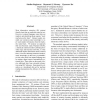250 search results - page 39 / 50 » Learning Probabilistic Models of Word Sense Disambiguation |
114
click to vote
ISAMI
2010
14 years 9 months ago
2010
Probabilistic models of languages are fundamental to understand and learn the profile of the subjacent code in order to estimate its entropy, enabling the verification and predicti...
ISWC
2002
IEEE
15 years 4 months ago
2002
IEEE
The Parasitic Humanoid (PH) is a wearable robot for modeling nonverbal human behavior. This anthropomorphic robot senses the behavior of the wearer and has the internal models to ...
AIED
2009
Springer
15 years 6 months ago
2009
Springer
We present a novel phoneme-based student model for spelling training. Our model is data driven, adapts to the user and provides information for, e.g., optimal word selection. We de...
129
click to vote
ISNN
2009
Springer
15 years 6 months ago
2009
Springer
In this paper, we introduce a new instance-based approach to the label ranking problem. This approach is based on a probability model on rankings which is known as the Mallows mode...
116
click to vote
ACL
2012
13 years 2 months ago
2012
Most information extraction (IE) systems identify facts that are explicitly stated in text. However, in natural language, some facts are implicit, and identifying them requires â€...

